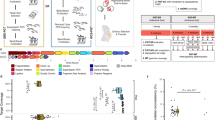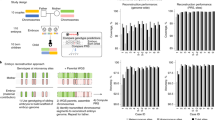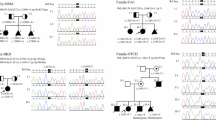Abstract
Although morally acceptable in theory, preimplantation genetic diagnosis (PGD) for mitochondrial DNA (mtDNA) disorders raises several ethical questions in clinical practice. This paper discusses the major conditions for good clinical practice. Our starting point is that PGD for mtDNA mutations should as far as possible be embedded in a scientific research protocol. For every clinical application of PGD for mtDNA disorders, it is not only important to avoid a ‘high risk of serious harm’ to the future child, but also to consider to what extent it would be possible, desirable and proportional to try to reduce the health risks and minimize harm. The first issue we discuss is oocyte sampling, which may point out whether PGD is feasible for a specific couple. The second issue is whether one blastomere represents the genetic composition of the embryo as a whole – and how this could (or should) be investigated. The third issue regards the cutoff points below which embryos are considered to be eligible for transfer. We scrutinize how to determine these cutoff points and how to use these cutoff points in clinical practice – for example, when parents ask to take more or less risks. The fourth issue regards the number of cycles that can (or should) justifiably be carried out to find the best possible embryo. Fifth, we discuss whether follow-up studies should be conducted, particularly the genetic testing of children born after IVF/PGD. Finally, we offer the main information that is required to obtain a truly informed consent.
Similar content being viewed by others
Log in or create a free account to read this content
Gain free access to this article, as well as selected content from this journal and more on nature.com
or
References
Bredenoord AL, Pennings G, Smeets HJ, De Wert GM : Dealing with uncertainties: ethics of prenatal diagnosis and preimplantation genetic diagnosis to prevent mitochondrial disorders. Hum Reprod Update 2008; 14: 83–94.
Bredenoord AL, Dondorp WJ, Pennings G, De Die-Smulders CEM, de Wert G : PGD to reduce reproductive risk: the case of mitochondrial DNA disorders. Hum Reprod 2008; 23: 2392–2401.
De Wert GM : The post-menopause: playground for reproductive technology? Some ethical reflections; in Harris J and Holm S (eds): The Future of Human Reproduction. Ethics, Choice and Regulation. Oxford: Clarendon Press, 1998, pp 221–237.
Pennings G : Measuring the welfare of the child: in search of the appropriate evaluation principle. Hum Reprod 1999; 14: 1146–1150.
Bickerstaff H, Flinter F, Yeong CT, Braude P : Clinical application of preimplantation genetic diagnosis. Hum Fertil 2001; 4: 24–30.
Steffann J, Frydman N, Gigarel N et al: Analysis of mtDNA variant segregation during early human embryonic development: a tool for successful NARP preimplantation diagnosis. J Med Genet 2006; 43: 244–247.
Briggs DA, Power NJ, Lamb V, Rutherford AJ, Gosden RG : Amplification of DNA sequences in polar bodies from human oocytes for diagnosis of mitochondrial disease. Lancet 2000; 335: 1520–1521.
Dean NL, Battersby BJ, Ao A, Gosden RG, LinTan S, Shoubridge EA : Prospect of preimplantation genetic diagnosis for heritable mitochondrial DNA diseases. Mol Hum Reprod 2003; 9: 631–638.
Poulton J, Turnbull DMA : 74th ENMC international workshop: mitochondrial diseases 19–20 November 1999, Naarden, The Netherlands. Neuromuscul Disord 2000; 10: 460–462.
White SL, Collins VR, Wolfe R et al: Genetic counseling and prenatal diagnosis for the mitochondrial DNA mutations at nucleotide 8993. Am J Hum Genet 1999; 65: 474–482.
White SL, Shanske S, McGill JJ et al: Mitochondrial DNA mutations at nucleotide 8993 show a lack of tissue or age-related variation. J Inherit Metab Dis 1999; 22: 899–914.
Dahl HHM, Thorburn DR, White SL : Towards reliable prenatal diagnosis of mtDNA point mutations: studies of nt8993 mutations in oocytes, fetal tissues, children and adults. Hum Reprod 2000; 15 (suppl 2): 246–255.
Tatuch Y, Christodoulou J, Feigenbaum A et al: Heteroplasmic mtDNA mutation (T-G) at 8993 can cause Leigh disease when the percentage of abnormal mtDNA is high. Am J Hum Genet 1992; 50: 852–858.
Ciafaloni E, Santorelli FM, Shanske S et al: Maternally inherited Leigh syndrome. J Pediatr 1993; 122: 419–422.
Chinnery PF : Inheritance of mitochondrial disorders. Mitochondrion 2002; 2: 149–155.
Chinnery PF, Howell N, Lightowlers RN, Turnbull DM : MELAS and MERFF. The relationship between maternal mutation load and the frequency of clinically affected offspring. Brain 1998; 121 (Part 10): 1889–1894.
Poulton J, Marchington DR : Segregation of mitochondrial DNA (mtDNA) in human oocytes and in animal models of mtDNA disease: clinical implications. Reproduction 2002; 123: 751–755.
Blok RB, Gook DA, Thorburn DR, Dahl HHM : Skewed segregation of the mtDNA nt 8993 (T-G) mutation in human oocytes. Am J Hum Genet 1997; 60: 1495–1501.
Brown DT, Samuels DC, Michael EM, Turnbull DM, Chinnery PF : Random genetic drift determines the level of mutant mtDNA in human primary oocytes. Am J Hum Genet 2001; 68: 533–536.
Mertes H, Pennings G : Oocyte donation for stem cell research. Hum Reprod 2006; 22: 629–634.
Pennings G, De Wert GM, Shenfield F, Cohen J, Tarlatzis B, Devroey P : ESHRE task force on ethics and law 12: oocyte donation for non-reproductive purposes. Hum Reprod 2007; 22: 1210–1213.
Sandel M : The Case against Perfection. Cambridge and London: The Belknap Press of Harvard University Press, 2007.
Devolder K : Creating and sacrificing embryos for stem cells. J Med Ethics 2005; 31: 366–370.
Dondorp WJ, de Wert GMWR : Embryonic Stem Cells Without Moral Pain? The Hague: Centre for Ethics and Health/Health Council of the Netherlands, 2005.
Cohen J, Wells D, Munné S : Removal of 2 cells from cleavage stage embryos is likely to reduce the efficacy of chromosomal tests that are used to enhance implantation rates. Fertil Steril 2007; 87: 496–503.
Combelles CMH : What are the trade-offs between one-cell and two-cell biopsies of preimplantation embryos? Hum Reprod 2008; 23: 493–498.
Goossens V, De Rycke M, De Vos A et al: Diagnostic efficiency, embryonic development and clinical outcome after the biopsy of one or two blastomeres for preimplantation genetic diagnosis. Hum Reprod 2008; 23: 481–492.
Pettman R, Hurley T, Robinson B, Scott H, Kronick JB : Prenatal diagnosis by amniocentesis and chorionic villus biopsy of mtDNA mutation 8993T>G. J Inherit Metab Dis 2007; 30: 404.
Chinnery PF, Taylor DJ, Brown DT, Manners D, Styles P, Lori R : Very low levels of the mtDNA A3243G mutation associated with mitochondrial dysfunction in vivo. Ann Neurol 2000; 47: 381–384.
Jacobs LJAM, De Coo IFM, Nijland JG et al: Transmission and prenatal diagnosis of the T9176C mitochondrial DNA mutation. Mol Hum Reprod 2005; 11: 223–228.
Harper JC, De Die-Smulders C, Goossens V et al: ESHRE PGD consortium data collection VII: cycles from January to December 2004 with pregnancy follow-up to October 2005. Hum Reprod 2008; 23: 741–755.
Chen SH, Escudero T, Cekleniak NA, Sable DB, Garrisi MG, Munné S : Patterns of ovarian response to gonadotropin stimulation in female carriers of balanced translocation. Fertil Steril 2005; 83: 1504–1509.
Heijnen E, Eijkemans M, De Klerk C et al: A mild treatment strategy for in-vitro fertilisation: a randomised non-inferiority trial. Lancet 2007; 369: 743–749.
Lavery SA, Aurell R, Turner C et al: Preimplantation genetic diagnosis: patient's experiences and attitudes. Hum Reprod 2002; 17: 2464–2467.
Magli MC, Gianaroli L, Grieco N, Cefalu E, Ruvolo G, Ferraretti AP : Cryopreservation of biopsied embryos at the blastocyst stage. Hum Reprod 2006; 21: 2656–2660.
Parriego M, Solé M, Aurell R, Barri PN, Veiga A : Birth after transfer of frozen-thawed vitrified biopsied blastocysts. J Assist Reprod Genet 2007; 24: 147–149.
DiMauro S, Hirano M, Schon EA : Approaches to the treatment of mitochondrial diseases. Muscle Nerve 2006; 34: 265–283.
Robertson S, Savulescu J : Is there a case in favour of predictive genetic testing in young children? Bioethics 2001; 15: 26–49.
Rhodes R : Why test children for adult-onset genetic diseases? Mt Sinai J Med 2006; 73: 609–616.
Smith T : Ethics in Medical Research. A Handbook of Good Practice. Cambridge: Cambridge University Press, 1999.
The World Medical Association: World Medical Association Declaration of Helsinki. Ethical Principles for Medical Research Involving Human Subjects. Geneva: World Medical Association, 2008.
Council for International Organizations of Medical Sciences: International Ethical Guidelines for Biomedical Research Involving Human Subjects. Geneva: CIOMS, 2002.
Sue CM, Quigley A, Katsabanis S et al: Detection of MELAS A3243G point mutation in muscle, blood and hair follicles. J Neurol Sci 1998; 161: 36–39.
Wendler D, Varma S : Minimal risk in pediatric research. J Pediatr 2006; 149: 855–861.
Caldwell PHY, Murphy SB, Butow PN, Craig JC : Clinical trials in children. Lancet 2004; 364: 803–811.
Acknowledgements
This work was supported by a grant from the European Union Sixth Research Framework Programme (the MITOCIRCLE project contract no 005260). We thank Professor Dr J Geraedts for his valuable comments.
Author information
Authors and Affiliations
Corresponding author
Rights and permissions
About this article
Cite this article
Bredenoord, A., Dondorp, W., Pennings, G. et al. Preimplantation genetic diagnosis for mitochondrial DNA disorders: ethical guidance for clinical practice. Eur J Hum Genet 17, 1550–1559 (2009). https://doi.org/10.1038/ejhg.2009.88
Received:
Revised:
Accepted:
Published:
Issue date:
DOI: https://doi.org/10.1038/ejhg.2009.88
Keywords
This article is cited by
-
A national perspective on prenatal testing for mitochondrial disease
European Journal of Human Genetics (2014)
-
Preimplantation genetic diagnosis for inherited neurological disorders
Nature Reviews Neurology (2014)
-
Patient and family trajectories of mitochondrial disease: diversity, uncertainty and genetic risk
Life Sciences, Society and Policy (2013)
-
Präimplantationsdiagnostik für monogen vererbte Erkrankungen
Medizinische Genetik (2011)



